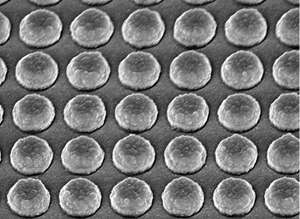Nanostructures filter light to order

Arrays of nanoscale pillars made to reflect light of a selected color could find application as optical filters in digital cameras.
A beam of sunlight is a mixture of different-colored light, including all the colors of the rainbow. Filtering or blocking a specific color, or colors, is often important in photography, color displays and other imaging techniques. An international team of engineers has now fabricated arrays of silver nanoscale pillars that can selectively reflect light of any desired color1. The team, led by Jinghua Teng and Yan Jun Liu at the A*STAR Institute of Materials Research and Engineering in Singapore, show that the color can be selected by varying the size of the pillars.
The stained glass in the windows of a church owes its color in part to an effect called surface plasmon resonance: light passing through the window interacts with electrons in the nanometer-sized metallic impurities that are trapped in the glass.
Light of a specific color, or wavelength, forces these electrons to quickly oscillate. In turn, the oscillating electrons enhance the amount of light transmitted through the glass at this wavelength. Teng, Liu and their co-workers were able to transfer this plasmonic effect from light-transmitting windows to light-reflecting mirrors. "Our compact reflectors could be used for applications including color coding, anti-counterfeiting and product branding," says Teng.
The researchers deposited 6 nanometers of titanium, followed by 180 nanometers of silver on a quartz substrate. Onto the silver layer, they etched arrays of cylinders with diameters of 300 to 500 nanometers and a center-to-center separation of 320 to 540 nanometers (see image). The resulting gap between some of the pillars was as small as 20 nanometers. To achieve these tiny features, the team used a technique called electron-beam lithography: they scanned a beam of electrons to pattern the required features onto a protective layer placed on top of the silver. Then, they used a stream of charged ion atoms to mill the exposed metal and create the nanopillars.
After construction, Teng, Liu and their team shone white light onto each of the arrays and measured the wavelength of the reflected radiation. Arrays of cylinders of 500 nanometers in diameter and separated by 40 nanometers appeared red because they predominantly reflected light with a wavelength of 630 nanometers. Similarly, pillars with a diameter of 300 nanometers and a separation of 20 nanometers appeared blue as they reflected light with a 490-nanometer wavelength.
"We are now working to further develop this technique to create large-area color displays," says Teng. "We also aim to develop applications and collaborations with industry."
More information: Si, G., Zhao, Y., Lv, J., Lu, M., Wang, F. et al. Reflective plasmonic color filters based on lithographically patterned silver nanorod arrays. Nanoscale 5, 6243–6248 (2013). article: dx.doi.org/10.1039/c3nr01419c
Journal information: Nanoscale




















